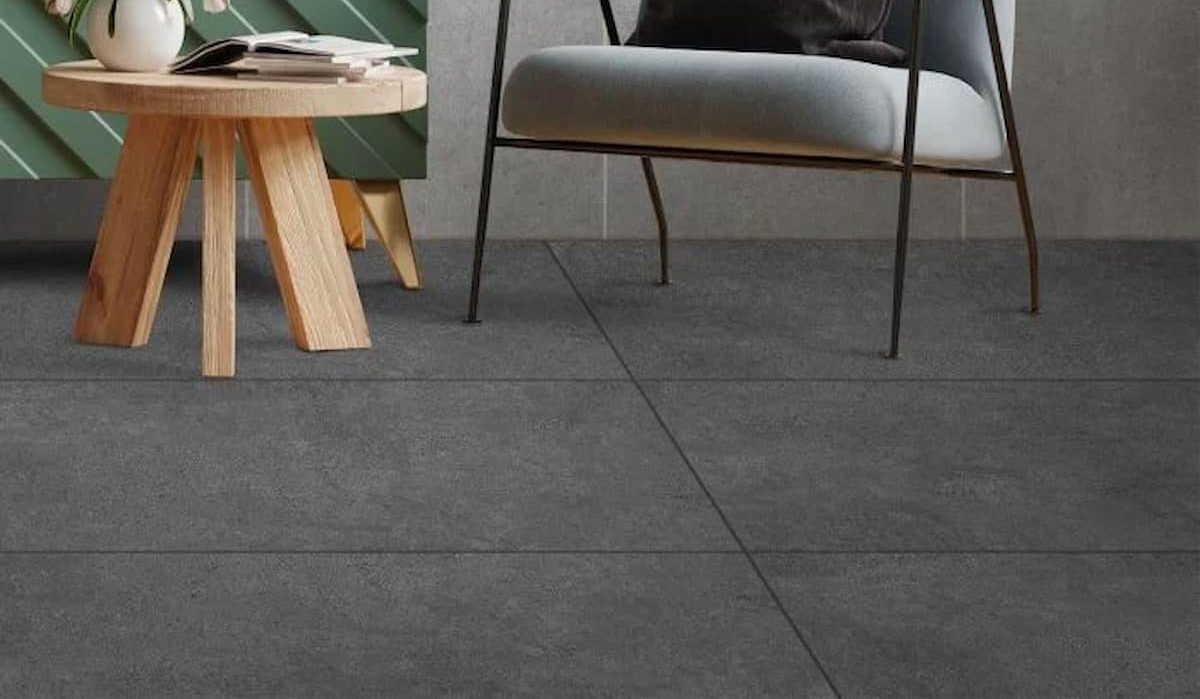When working with large format type of tiles, you need to exercise extreme caution, take care of movements, cutting, employ the assistance of at least two people, and make use of specialized tools and equipment. This is true both when you are handling the tiles while they are still wrapped in their packaging and when you are performing any cutting, drilling, or installation tasks. If they are not handled and raised in the appropriate manner, large format tiles can easily be bent, and even broken, thus extra caution is essential when working with them. Because of the massive size of the tiles, you should always check well in advance to ensure that there will be sufficient area and space on the site to comfortably maneuver them. It is recommended that the boxes and crates that hold the tiles be brought as close as possible to the location in which they will be installed in order to minimize the distance that will need to be traveled when carrying the tiles. When the tiles have been removed from their packaging, the next step is to carefully position them by placing the long side of the tiles on the ground at an angle of 30 degrees to the support. This step must be performed before the tiles may be used. When you are handling the tiles, it is important to pay special attention to the corners so that you do not chip or break any of them.  It is recommended that the tiles be transported and installed using runners and frames equipped with suction cups. This will make the tiles more robust and reduce the likelihood that they will bend or twist under their own weight. There is the standard form of suction cup, as well as a variety that has an internal pump built into it. Both types are available. The latter variety is safer and offers a better hold, and the vacuum in the suction cup can be re-established using the pump even after a predetermined amount of time has passed. Always check to see that a sufficient vacuum has been generated between the surface of the tile and the instrument that is doing the lifting. In order to obtain a better hold on the tile, it is advisable to clean the surface of the tile as well as the suction cups with a damp sponge. If the tile has been cut and is potentially weaker in that location, it is recommended to add additional runners or cross-members to reduce any bend or twist in the tile. This can be done by adding more runners or cross-members. If you need to make a cut of any kind, whether it be a straight cut along a tile, holes for pipes or switchboxes, or any other kind of cut, it is highly suggested that you take the following precautions when carrying out these operations.
It is recommended that the tiles be transported and installed using runners and frames equipped with suction cups. This will make the tiles more robust and reduce the likelihood that they will bend or twist under their own weight. There is the standard form of suction cup, as well as a variety that has an internal pump built into it. Both types are available. The latter variety is safer and offers a better hold, and the vacuum in the suction cup can be re-established using the pump even after a predetermined amount of time has passed. Always check to see that a sufficient vacuum has been generated between the surface of the tile and the instrument that is doing the lifting. In order to obtain a better hold on the tile, it is advisable to clean the surface of the tile as well as the suction cups with a damp sponge. If the tile has been cut and is potentially weaker in that location, it is recommended to add additional runners or cross-members to reduce any bend or twist in the tile. This can be done by adding more runners or cross-members. If you need to make a cut of any kind, whether it be a straight cut along a tile, holes for pipes or switchboxes, or any other kind of cut, it is highly suggested that you take the following precautions when carrying out these operations.  Tile needs to be placed on a stable, flat, and sturdy work surface in order to achieve a clean cut or an accurate hole. This is necessary in order to achieve either goal. When you want to make a cut that is perfectly straight, position the cutting guide on the tile so that it is along the line that will be cut, and then secure it with suction cups. First, make a short cut on either end of the tile measuring between one and two centimeters in length from the inside towards the exterior, and then finish cutting the tile from one end to the other. It is imperative that you maintain a consistent amount of pressure on the cutting tool throughout the entirety of the cut. Once the cut has been finished, remove the cutting guide and reposition the tile such that the cut formed in the surface sits over the edge of the work surface. After that, use tile snips to break each end of the tile along the line of the cut. After that, the tile is bent until it can no longer be held together into a single piece, at which point it is snapped in half. In order to prevent the item from falling or breaking during this operation, it is normally advisable to use the assistance of two individuals. If there is reinforcement mesh in the tile this can be cut and trimmed with a cutter.
Tile needs to be placed on a stable, flat, and sturdy work surface in order to achieve a clean cut or an accurate hole. This is necessary in order to achieve either goal. When you want to make a cut that is perfectly straight, position the cutting guide on the tile so that it is along the line that will be cut, and then secure it with suction cups. First, make a short cut on either end of the tile measuring between one and two centimeters in length from the inside towards the exterior, and then finish cutting the tile from one end to the other. It is imperative that you maintain a consistent amount of pressure on the cutting tool throughout the entirety of the cut. Once the cut has been finished, remove the cutting guide and reposition the tile such that the cut formed in the surface sits over the edge of the work surface. After that, use tile snips to break each end of the tile along the line of the cut. After that, the tile is bent until it can no longer be held together into a single piece, at which point it is snapped in half. In order to prevent the item from falling or breaking during this operation, it is normally advisable to use the assistance of two individuals. If there is reinforcement mesh in the tile this can be cut and trimmed with a cutter.  After the tile has been broken, the edges of the tile may be jagged or uneven; use a diamond pad or an abrasive disk to polish and smooth the edges. Before cutting a tile, a hole must first be drilled into the corner of the tile if the tile needs to be trimmed in more than one way. A disk cutter can also be used to make a cut in a straight line. When this occurs, the disk cutter moves along the cutting guide, and either a complete cut or an incomplete cut may be produced as a result. In this scenario, the tile will have a crisper and more clearly defined edge in comparison to the case where the tile was cut and broken. If a tile needs to have round holes cut into it, a dry or wet diamond cutter is the tool to employ. Once the tile has been positioned on the work surface and the location of the hole has been chalked out, begin making the hole with the cutting head situated at an angle with respect to the tile so that it cuts through it with more precision.
After the tile has been broken, the edges of the tile may be jagged or uneven; use a diamond pad or an abrasive disk to polish and smooth the edges. Before cutting a tile, a hole must first be drilled into the corner of the tile if the tile needs to be trimmed in more than one way. A disk cutter can also be used to make a cut in a straight line. When this occurs, the disk cutter moves along the cutting guide, and either a complete cut or an incomplete cut may be produced as a result. In this scenario, the tile will have a crisper and more clearly defined edge in comparison to the case where the tile was cut and broken. If a tile needs to have round holes cut into it, a dry or wet diamond cutter is the tool to employ. Once the tile has been positioned on the work surface and the location of the hole has been chalked out, begin making the hole with the cutting head situated at an angle with respect to the tile so that it cuts through it with more precision.  Once the hole has been made, move on to the next tile. After the cutting head has begun to form the hole, you will need to press down and make a little circular motion. If you are using the wet approach, you should keep the cutting area moist. If you are using the dry method, you should remove all of the dust that results from the drilling operation. If you need to make a rectangular hole in a tile, you should begin by making a round hole in each corner of the rectangle. After that, use a disk cutter that has a diamond disk to make straight cuts in between each hole in the tile. Because of this, excessive strains won't be formed at the corners of the rectangle, where they could have led to the formation of a crack in the tile itself. Our professional exporting team would be glad to cooperate with all traders and importers from anywhere on earth.
Once the hole has been made, move on to the next tile. After the cutting head has begun to form the hole, you will need to press down and make a little circular motion. If you are using the wet approach, you should keep the cutting area moist. If you are using the dry method, you should remove all of the dust that results from the drilling operation. If you need to make a rectangular hole in a tile, you should begin by making a round hole in each corner of the rectangle. After that, use a disk cutter that has a diamond disk to make straight cuts in between each hole in the tile. Because of this, excessive strains won't be formed at the corners of the rectangle, where they could have led to the formation of a crack in the tile itself. Our professional exporting team would be glad to cooperate with all traders and importers from anywhere on earth.
💰 Tenfold your income 💎
